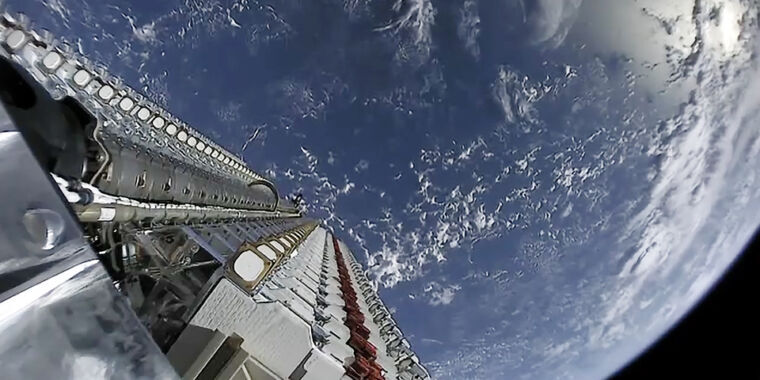- cross-posted to:
- spaceflight
- cross-posted to:
- spaceflight
This will be the first Ars Live event we’ve done in a few years. During these discussions, reporters and editors at Ars Technica speak with industry leaders about the most important technology and science news of the day. So please join us at 2 pm ET (18:00 UTC) on June 11 on our YouTube livestream.
Impressive. In the world of high-amounts-of-capital-required-to-start businesses, I think space internet is up near the top. That gives de-facto monopoly status to anyone who can launch.
I guess it helps when you also control the rocket company, which had government money to help develop.
There were a number of high profile attempts before this and they all sucked or failed.
Either way I’m pretty uncomfortable with Elon being in charge of this thing and hope he gets some competition soon.
I agree with everything you said and especially with the hope for competition (which in some ways there is, SpaceX is just miles ahead), but I just wanted to point out that basically every rocket ever developed was done with government funding :)
This is the best summary I could come up with:
SpaceX began launching operational Starlink satellites five years ago this month.
SpaceX has now launched about 6,000 satellites with its Falcon 9 rocket and has delivered on its promise to provide fast Internet around the world.
In addition to rapidly growing its subscriber base of about 3 million, SpaceX has also managed to control costs.
Based upon its model, therefore, Quilty estimates that Starlink’s free cash flow from the business will be about $600 million this year.
Are there credible competitors to Starlink in OneWeb, Amazon’s Project Kuiper, or other planned megaconstellations?
During these discussions, reporters and editors at Ars Technica speak with industry leaders about the most important technology and science news of the day.
The original article contains 324 words, the summary contains 116 words. Saved 64%. I’m a bot and I’m open source!
Are there credible competitors to Starlink in OneWeb, Amazon’s Project Kuiper, or other planned megaconstellations?
Well no, at least not in the megaconstellations class as literally NO ONE has access to the same low launch cost or high volume launch capacity without paying for trips on SpaceX.
There was a lot of talk about how Amazon’s Project Kuiper was going to catch up but it is physically and financially impossible at the moment due to launch capacity of Amazon’s launch partners and even with Kuiper requiring few sat launches. I would have to go back and do the math again but they had like 3 partners that are currently CAPABLE (BlueOrigan is still sub orbital and waiting on New Glenn to work) and even if they use ALL theoretical launch’s at MAX capacity I think it was going to take them something like 3 years to launch the complete Kuiper constellation…
SpaceX effectively has a monopoly on high speed / low latency satellite internet for the next 5+ years
New Glenn might actually launch this year, which would be amazing. We’re starting to see a lot of flight hardware… Not holding my breath though.
✅Vulcan
🔜Ariane 6
🔜New Glenn
The Kuiper fleet is starting to come together, but getting to an operational cadence is another question.
Amazon also has to actually build satellites at some point. They could have already been launching on the Atlas Vs they bought. And having Kuiper sats ready would mean ULA doesn’t have to launch the 2nd Vulcan with a mass sim.
They could have already been launching on the Atlas Vs they bought
They did do a launch last
DecemberOctober. They need to pick up the pace a bit.I guess that delay from the Kuiper test sats in Oct '23 to the first operational launch soon™ isn’t really different from SpaceX going from the Tintin test sats in Feb '18 to operational sats in May '19. I’m just impatient.
Three major caveats here:
1 - Free cash flow doesn’t actually mean profitability. It doesn’t include, as a prime example, expenditure of satellites, only the actual replacement sats launched. Starlink satellites have a life expentancy of about 5 years, so to calculate profit, you need to add 1/5th of the cost of your satellite network to your yearly expenses. For free cash flow, you only have to take account of the actual expenses. So, if you buy a 100k car every 5 years, your profit-statement will show 20k in car-costs per year. But your free cash flow will show 4 years of nothing, followed by 100k.
Starlink had very few sats 5 years ago, so they’re barely replacing anything yet, the FCF is 4 years behind the yearly costs of the Profit.
2 - A lot of Starlink income currently is from selling terminals, which is a very finite market. You only sell terminals to new customers, not existing ones.
3 - Nobody can actually check these numbers, since they’re not public. We have no idea how realistic they are.
2 - A lot of Starlink income currently is from selling terminals, which is a very finite market.
3 - Nobody can actually check these numbers, since they’re not public.
Excellent points.
I am less convinced by your first point. While they haven’t had many satellites reach end-of-life yet, they certainly haven’t slowed their pace of Starlink launches. Are the cost of these launches factored into the FCF calculation? (I know very little about economics)
Also, they will likely want to switch Starlink launches over to Starship as soon as possible, as that will allow them to launch more, larger satellites (v3) for cheaper. If they can have positive cash flow while they are still building out the constellation using a (relatively) expensive launch vehicle, would that not bode well for long-term profitability?



